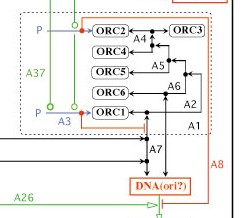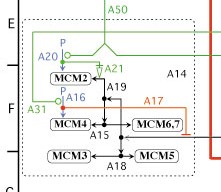Use Case Name : ../CompoundBinding |
For Feature : ../MIMEditor |
Editors: DavidKane |
<<TableOfContents: execution failed [Argument "maxdepth" must be an integer value, not "[2]"] (see also the log)>>
Summary
A user wants to describe the possibility that a species (protein or complex) binds with another species (protein or complex).
Step-by-Step User Action
- User specifies a species to be involved in the interaction
- A dot on the edge describing the complex indicates that it is used in a further reaction
- User specifies another species to be involved in the interaction
- User specifies that there is a binding relationship between the species
- User specifies the evidence for this relationship
Visual Aides
The Kohn notation for this binding is the following. In this example, a species (the complex AB) binds to another species (protein C):

Requirements for Cytoscape
Best mapped to a group. A and B are connected and are part of the group, and that group with C would be involved in a another group. The edge might be a new node type. The visualization of the Kohn notation would require changes to the rendered and the vizmapper.
Importance
This is another basic building block of the Kohn notation. The concept of the result of a reaction being involved in subsequent reactions occurs repeatedly
Other Examples
Variations
A complex can be involved in more than one interaction. If a complex is involved in more than one interaction, the additional dots are placed on the edge for each reaction.

The product of compound binding can be used in additional reactions, just as the results of ../NonCovalentBinding can.

The product of two compound bindings can also be involved in a reaction with each other.

The layout rules for the edges for bindings require that they be horizontal or vertical, and may have any number of right angles. The edges may cross other edges at right angles.
Comments
Shared ../MimEditorUseCaseComments
The BioPAX representation of this binding could be a Conversion Object, i.e. with Participants = AB, C, ABC, Left = AB,C, Right=ABC, where C is a Protein, AB is a Complex with components A and B, and ABC is a Complex with components AB,C)
AllanKuchinsky 2006-11-16 04:50:22
The right-angle constraint seems to limit to 4 the number of species that can directly connect to a complex. Is this the case? How would one represent a complex with 5 species? Would that require the addition of a second complex (dot)? Would that, however, imply a degree of hierarchical organization that is not really there? Is this a use case that is so rare as to not be considered?
AllanKuchinsky 2006-11-17 02:43:04
Within the editor, would the user connect to the existing species by drawing an edge to the dot? We will need to modify the DGraphView class to accomodate grous in the method for determining which node is prominent at a given coordinate. This is an issue for the View aspect of Groups in general, i.e. in distinguishing whether a particular UI gesture is made in the context of the group itself or one of its contained elements. In the case of MIMs, the View aspect of the Group may be represented by the dot, rather than a bounding box around the contained elements.
MiritAladjem 2007-02-01 08:39:00
Complexes of more than 4 members can be depicted in several ways. One way is to assume an order of complex formation and depict sub-complexes. For example in the ORC complex below, there are 7 members. The first two members (ORC2 and ORC3) bind each other to form a sub-complex, which in turn binds ORC4 to form the next subcomplex etc.
The second way is to create a molecular species that is in itself a complex. The MCM example below shows MCM6,7 as a single molecular species. If two members of a complex are always interacting with other moleculr species together we can create a shortcut to the complex. This method does not imply a hierarchy within the complex.
Yes to create a complex, the user will need to add an edge to a primary molecular species or to a dot representing a modified molecular species or a result of an interaction (such as a sub-complex).
Figures For Comments
ORC Complex

MCM Complex
